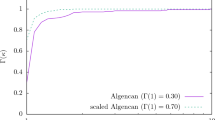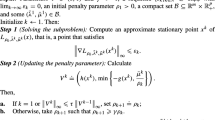Abstract
This paper discusses the use of a stopping criterion based on the scaling of the Karush–Kuhn–Tucker (KKT) conditions by the norm of the approximate Lagrange multiplier in the ALGENCAN implementation of a safeguarded augmented Lagrangian method. Such stopping criterion is already used in several nonlinear programming solvers, but it has not yet been considered in ALGENCAN due to its firm commitment with finding a true KKT point even when the multiplier set is not bounded. In contrast with this view, we present a strong global convergence theory under the quasi-normality constraint qualification, that allows for unbounded multiplier sets, accompanied by an extensive numerical test which shows that the scaled stopping criterion is more efficient in detecting convergence sooner. In particular, by scaling, ALGENCAN is able to recover a solution in some difficult problems where the original implementation fails, while the behavior of the algorithm in the easier instances is maintained. Furthermore, we show that, in some cases, a considerable computational effort is saved, proving the practical usefulness of the proposed strategy.

Similar content being viewed by others
Data Availability Statement
In the tests we use “the constrained nonlinear programming problems from CUTEst (available at github.com/ralna/CUTEst), including all from the Netlib (ftp://ftp.numerical.rl.ac.uk/pub/cutest/netlib) and the Maros & Meszaros (bitbucket.org/optrove/maros-meszaros) libraries. Mathematical programs with complementarity constraints from MacMPEC (available at wiki.mcs.anl.gov/leyffer/index.php/MacMPEC)” The quotation is in the manuscript, p. 12, 2nd paragraph.
References
Andreani, R., Birgin, E.G., Martínez, J.M., Schuverdt, M.L.: On augmented Lagrangian methods with general lower-level constraints. SIAM J. Optim. 18(4), 1286–1309 (2007). https://doi.org/10.1137/060654797
Andreani, R., Fazzio, N., Schuverdt, M., Secchin, L.: A sequential optimality condition related to the quasi-normality constraint qualification and its algorithmic consequences. SIAM J. Optim. 29(1), 743–766 (2019). https://doi.org/10.1137/17M1147330
Andreani, R., Haeser, G., Martínez, J.M.: On sequential optimality conditions for smooth constrained optimization. Optimization 60(5), 627–641 (2011). https://doi.org/10.1080/02331930903578700
Andreani, R., Haeser, G., Mito, L.M., Ramos, A., Secchin, L.D.: On the best achievable quality of limit points of augmented Lagrangian schemes. Tech. rep., Optimization Online (2020). http://www.optimization-online.org/DB_HTML/2020/07/7929.html
Andreani, R., Haeser, G., Schuverdt, M.L., Silva, P.J.S.: A relaxed constant positive linear dependence constraint qualification and applications. Math. Program. 135(1), 255–273 (2012). https://doi.org/10.1007/s10107-011-0456-0
Andreani, R., Martínez, J.M., Santos, L.T.: Newton’s method may fail to recognize proximity to optimal points in constrained optimization. Math. Program. 160(1), 547–555 (2016). https://doi.org/10.1007/s10107-016-0994-6
Andreani, R., Martinez, J.M., Schuverdt, M.L.: On the relation between constant positive linear dependence condition and quasinormality constraint qualification. J. Optim. Theory Appl. 125(2), 473–483 (2005). https://doi.org/10.1007/s10957-004-1861-9
Andreani, R., Martínez, J.M., Ramos, A., Silva, P.J.S.: A cone-continuity constraint qualification and algorithmic consequences. SIAM J. Optim. 26(1), 96–110 (2016). https://doi.org/10.1137/15M1008488
Andreani, R., Martínez, J.M., Ramos, A., Silva, P.J.S.: Strict constraint qualifications and sequential optimality conditions for constrained optimization. Math. Oper. Res. 43(3), 693–717 (2018). https://doi.org/10.1287/moor.2017.0879
Andreani, R., Martínez, J.M., Svaiter, B.F.: A new sequential optimality condition for constrained optimization and algorithmic consequences. SIAM J. Optim. 20(6), 3533–3554 (2010). https://doi.org/10.1137/090777189
Andreani, R., Secchin, L.D., Silva, P.J.S.: Convergence properties of a second order augmented Lagrangian method for mathematical programs with complementarity constraints. SIAM J. Optim. 28(3), 2574–2600 (2018). https://doi.org/10.1137/17M1125698
Bartholomew-Biggs, M.: Nonlinear Optimization with Financial Applications. Springer US (2005). https://doi.org/10.1007/b102601
Bartholomew-Biggs, M.: Nonlinear Optimization with Engineering Applications, Springer Optimization and Its Applications, vol. 19. Springer, US (2008). https://doi.org/10.1007/978-0-387-78723-7
Bertsekas, D.P.: Nonlinear Programming, 2nd edn. Athena Scientific (1999)
Bertsekas, D.P.: Convex Analysis and Optimization. Athena Scientific (2003)
Bertsekas, D.P., Ozdaglar, A.E.: Pseudonormality and a Lagrange multiplier theory for constrained optimization. J. Optim. Theory Appl. 114(2), 287–343 (2002). https://doi.org/10.1023/A:1016083601322
Birgin, E.G., Martínez, J.M.: Large-scale active-set box-constrained optimization method with spectral projected gradients. Comput. Optim. Appl. 23(1), 101–125 (2002). https://doi.org/10.1023/A:1019928808826
Birgin, E.G., Martínez, J.M.: Improving ultimate convergence of an augmented Lagrangian method. Optim. Methods Softw. 23(2), 177–195 (2008). https://doi.org/10.1080/10556780701577730
Birgin, E.G., Martínez, J.M.: Practical Augmented Lagrangian Methods for Constrained Optimization. Society for Industrial and Applied Mathematics, Philadelphia, PA (2014). https://doi.org/10.1137/1.9781611973365
Birgin, E.G., Martínez, J.M.: Complexity and performance of an augmented Lagrangian algorithm. Optimization Methods and Software, pp. 1–36 (2020). https://doi.org/10.1080/10556788.2020.1746962
Bueno, L., Haeser, G., Rojas, F.: Optimality conditions and constraint qualifications for generalized nash equilibrium problems and their practical implications. SIAM J. Optim. 29(1), 31–54 (2019). https://doi.org/10.1137/17M1162524
Büskens, C., Wassel, D.: The ESA NLP Solver WORHP, pp. 85–110. Springer New York, New York, NY (2013). https://doi.org/10.1007/978-1-4614-4469-5_4
Dolan, E.D., Moré, J.J.: Benchmarking optimization software with performance profiles. Math. Program. 91(2), 201–213 (2002). https://doi.org/10.1007/s101070100263
Fletcher, R., Leyffer, S.: User manual for filterSQP. Tech. Rep. NA/181, University of Dundee (1998). https://wiki.mcs.anl.gov/leyffer/images/5/58/SQP_manual.pdf
Gill, P.E., Kungurtsev, V., Robinson, D.P.: A stabilized SQP method: global convergence. IMA J. Numer. Anal. 37(1), 407–443 (2016). https://doi.org/10.1093/imanum/drw004
Gondzio, J.: Interior point methods 25 years later. Eur. J. Oper. Res. 218(3), 587–601 (2012). https://doi.org/10.1016/j.ejor.2011.09.017
Guignard, M.: Generalized Kuhn–Tucker conditions for mathematical programming problems in a Banach space. SIAM J. Control 7(2), 232–241 (1969). https://doi.org/10.1137/0307016
Janin, R.: Directional derivative of the marginal function in nonlinear programming. In: Fiacco, A. V. (ed.) Sensitivity, Stability and Parametric Analysis, Mathematical Programming Studies, vol. 21, pp. 110–126. Springer Berlin (1984). https://doi.org/10.1007/BFb0121214
Mangasarian, O., Fromovitz, S.: The Fritz John necessary optimality conditions in the presence of equality and inequality constraints. J. Math. Anal. Appl. 17(1), 37–47 (1967). https://doi.org/10.1016/0022-247X(67)90163-1
Murtagh, B.A., Saunders, M.A.: MINOS 5.51 user’s guide. Tech. Rep. SOL 83-20R, Stanford University (2003). https://web.stanford.edu/group/SOL/guides/minos551.pdf
Nocedal, J., Wright, S.J.: Numerical Optimization, 2nd edn. Springer, Berlin (2006)
Ozdaglar, A.E., Bertsekas, D.P.: The relation between pseudonormality and quasiregularity in constrained optimization. Optim. Methods Softw. 19(5), 493–506 (2004). https://doi.org/10.1080/10556780410001709420
Qi, L., Wei, Z.: On the constant positive linear dependence condition and its application to SQP methods. SIAM J. Optim. 10(4), 963–981 (2000). https://doi.org/10.1137/S1052623497326629
Secchin, L.D.: Scaled-algencan v1.0.0 (2021). doi: https://doi.org/10.5281/zenodo.5138345
Sra, S., Nowozin, S., Wright, S.J. (eds.): Optimization for Machine Learning. MIT Press, Neural Information Processing Series (2012)
Terlaky, T., Anjos, M.F., Ahmed, S.: Advances and Trends in Optimization with Engineering Applications. SIAM (2017)
Wächter, A., Biegler, L.T.: On the implementation of an interior-point filter line-search algorithm for large-scale nonlinear programming. Math. Program. 106(1), 25–57 (2006). https://doi.org/10.1007/s10107-004-0559-y
Ye, J.J., Zhang, J.: Enhanced Karush–Kuhn–Tucker condition and weaker constraint qualifications. Math. Program. 139(1), 353–381 (2013). https://doi.org/10.1007/s10107-013-0667-7
Author information
Authors and Affiliations
Corresponding author
Ethics declarations
Funding
This work has been partially supported by CEPID-CeMEAI (FAPESP 2013/07375-0), FAPES (Grant 116/2019), FAPESP (Grants 2017/18308-2 and 2018/24293-0), CNPq (Grants 301888/2017-5, 304301/2019-1 and 302915/2016-8) and PRONEX - CNPq/FAPERJ (grant E-26/010.001247/2016).
Conflict of interest
The authors declare that they have no conflict of interest.
Availability of data and materials
All data analyzed during this study are publicly available. URLs are included in this published article.
Code availability
ALGENCAN 3.1.1 is available under the GNU General Public License, as well as the proposed scaled version [34]. We emphasize that the HSL packages used in this study are available for academic use. URLs are included in this published article.
Additional information
Publisher's Note
Springer Nature remains neutral with regard to jurisdictional claims in published maps and institutional affiliations.
Rights and permissions
About this article
Cite this article
Andreani, R., Haeser, G., Schuverdt, M.L. et al. On scaled stopping criteria for a safeguarded augmented Lagrangian method with theoretical guarantees. Math. Prog. Comp. 14, 121–146 (2022). https://doi.org/10.1007/s12532-021-00207-9
Received:
Accepted:
Published:
Issue Date:
DOI: https://doi.org/10.1007/s12532-021-00207-9




